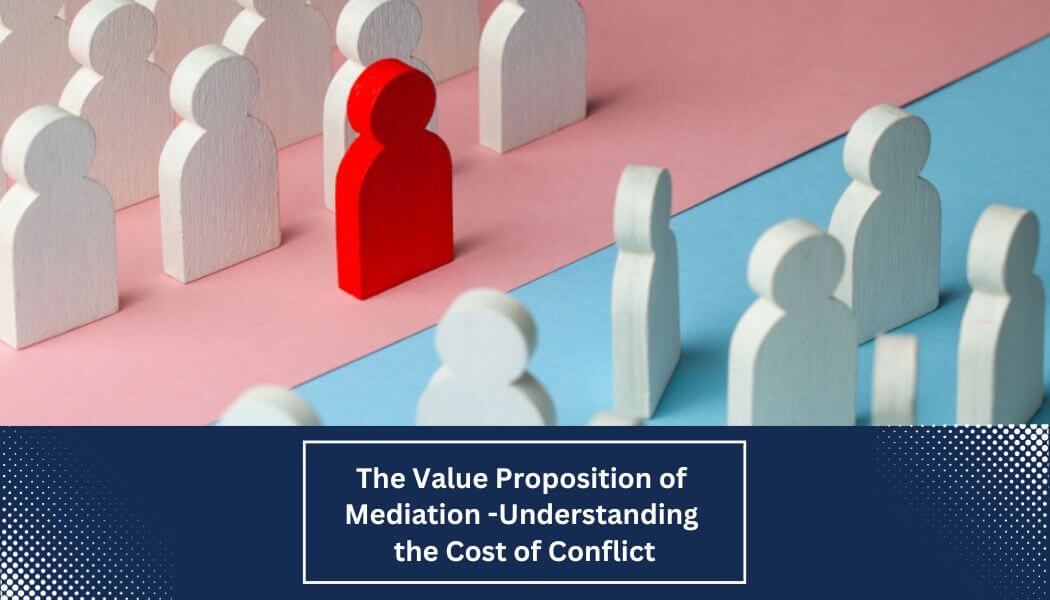What is The Cost of Conflict?
Conflict is a naturally occurring part of the human condition. When managed properly, conflict can lead to personal growth and development by forcing us to navigate different perspectives, think more creatively, and broaden our collective vision. Yet, there is a cost of conflict; therefore, many individuals ignore it in hopes that others can deal with it or that it will disappear altogether. If left unchecked or unmanaged, conflict can impede the growth and productivity of individuals, organizations, and governments. It stands to reason that helping others understand the cost of conflict and the value proposition of mediation, including strategies for conflict management and conflict resolution, is an essential step toward securing the future of our developing profession.
It is hard to comprehend, much less calculate fully, the value proposition of mediation without first understanding the true cost of conflict. A lot has been written to help businesses understand the high costs of conflict in the workplace. We know that certain conflict-related costs can be identified in a workplace dispute by looking at the following:
Direct Costs (easy to quantify)
The cost associated with outside counsel, in-house general counsel time, and support staff, including paralegals, experts, and administrative support. The economic cost of lost business, severance/termination packages, recruitment, and the training and development of replacing employees are all measurable costs of conflict.
Indirect Costs (more challenging to quantify)
Lost Opportunity Costs
It has been reported that senior executives of Fortune 500 companies spend over twenty percent of their time on ongoing litigation-related activities. When management is distracted, maintaining growth and strategic priorities is difficult. When combined with a conflict’s impact on employee morale, effective decision-making, and wasted time, this focus on conflict results in lost productivity and distracts from addressing an organization’s priorities and core objectives.
Lost/Damaged Relationships
Studies have shown that it costs an organization between 150% – 200% of an employee’s annual salary to replace that individual when one factor in the cost of recruiting, training, and bringing a new employee up to speed. The high cost of a lost relationship with a client, customer, vendor, or supplier can be even more impactful.
Emotional Toll
Several studies have shown that workplace conflict takes an emotional toll on those involved, as measured by increases in stress, sickness, job dissatisfaction, and workplace absences. In many instances, this leads to a rise in the cost of health care. Not surprisingly, this proves true not just for those directly involved in the dispute but also for team members who work on the fringes of the conflict environment.
Affected Company Culture
Conflict impacts a company’s brand and reputation with customers, clients, and employees. Each will decide which companies share their values and deserve their current and expected future business.
These additional hidden costs can prove to be just as detrimental to the long-term viability of a business as the direct economic costs seen on the balance sheet.
Calculating the Cost of Conflict
A few years back, I taught mediative competency skills to senior management and the heads of physicians and nurses at Stanford Healthcare. One day, over lunch with the then-CEO, I asked him to identify a dispute that had required his time and focus. I then suggested that he quantify the cost by itemizing the time and dollars spent by himself and others in the organization (managers, legal team, and support staff). We then discussed the lost productivity costs associated with the conflict. When comparing the estimated total costs with the price of hiring a skilled mediator, the results were striking. And that is just for one healthcare organization.
In another example, in Brazil, where we train lawyers to best represent clients in the mediation process, a colleague sent me an article on a study she led analyzing three large Brazilian companies and the economic benefits of mediating business conflicts. All three reported similar advantages: a dramatic reduction in costs, increased client satisfaction, and improved company reputation and relationships.
Over the last few years, I’ve given talks to organizations, including ombuds, judiciaries, other governmental agencies, chambers of commerce, bankers’ associations, and even stock exchanges in various countries, all interested in implementing or expanding mediation in their jurisdiction. In each instance, the audience is keenly aware of the direct costs associated with conflict management but has not yet been able to quantify the indirect costs. To address the true cost of conflict to their institutions, I suggested they gain the buy-in of senior management to look at workplace conflict from one of two perspectives:
- For a defined period, say one year, attempt to identify the types of conflicts addressed by management, general counsel, human resources, or ombudsman. Then, calculate the hard and soft costs incurred due to those conflicts. OR
- Select a typical conflict within the organization and perform the same analysis.
Several Cost of Conflict Calculators are now available to aid and enable business leaders to quantify the true cost of conflict within their organizations (Resologics has an easy-to-follow calculator that we are familiar with; however, many others exist).
Whatever the cost-measuring tool or approach used, only by understanding the true cost of conflict to individuals, organizations, institutions, and communities can one fully appreciate the value of conflict competence (including conflict management and conflict resolution strategies).
The Value of Mediation
While much has been done to study and help quantify the cost of conflict in various environments, very little has been offered to support the value proposition of mediation itself. As mediators, we are well versed in touting the many benefits of mediation: cost effectiveness, time savings, repaired relationships, psychological health and well-being, etc. Yet, when it comes to quantifying these benefits through empirical studies or even well-supported anecdotal evidence, the store shelf is glaringly empty.
Why haven’t we, as a profession, done a better job supporting the case for a process that we all know to be extraordinarily effective? I suspect there are several reasons.
As mediators, we tend to work in the shadows of the legal profession, plying our skills in a confidential environment. When a dispute is resolved, the parties are psychologically predisposed to want to move on, putting all aspects of the dispute behind them. The mediator herself, engaged for a limited purpose, quickly moves on to the next battlefront. Yet, what’s lost is the opportunity to quantify the savings to those pulled back from the ledge; however, those savings are defined.
When several of my colleagues at JAMS successfully mediated the lawsuits arising from the 58-story Millennium Tower in San Francisco that had sunk 18 inches and was leaning an almost equal amount, more than 100 attorneys’ time and several years of courtroom resources hung in the balance. When that dispute was concluded by mediation and essential repairs of the building were allowed, extraordinary economic, if not lifesaving, benefits resulted for everyone involved.
Similar results can result from mediations involving banking failures, fire losses, intellectual property disputes, and mass tort lawsuits. While these may be extreme examples, everyday mediators take on seemingly impossible tasks and assist parties in conflict to reach workable solutions. Doesn’t capturing the value that participants experience directly from the mediation process make sense?
Quantifying the Value Proposition of Mediation
How can mediators and others attempt to quantify the value proposition of mediation better? First, in selected cases and upon successful resolution, we should create the opportunity for the military equivalent of an “After Action Report.” The mediation intervention in a particular conflict would be carefully examined to identify various objectively measured savings. Indeed, this cost analysis would need to be structured to ensure the proprietary nature of the information provided, and there would be challenges in measuring the more subjective value of repaired relationships, regained opportunities, and improved psychological well-being.
Coming Together as a Profession to Measure the True Cost of Conflict
Yet, this deep dive, post mortem, done while the dispute is still fresh in its potential impact, would provide a veritable library of case-specific benefits, almost a Harvard Business School case study approach to conflict valuation. When viewed through the forward-looking lens of a modified cost calculator, for example, it would afford those implicated in future conflicts the data points on which to base important decisions about how to address conflict, including the value of mediation.
Imagine the potential application for artificial intelligence if, years in the future, we can look back on thousands of case studies showing quantifiable outcomes and measurable savings brought about by mediation.
Second, we as mediators need to do a better job of helping raise the value proposition of non-adjudicative resolution methods in our broader communities, not for purposes of self-promotion but to bring the power of mediation out of the shadows and into the light of broader acceptance by society. The exact process that favorably impacts family disputes, community disputes, and commercial litigation needs to make its way into public discourse, education, and policy formation.
In conclusion, only when mediation has found its rightful place in the world as the intervention of first choice for all manner of conflict resolution will we have succeeded in establishing the value proposition of mediation. And that starts with quantifying the cost of conflict.







